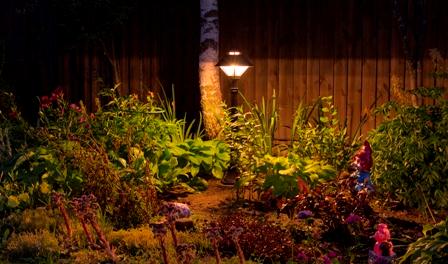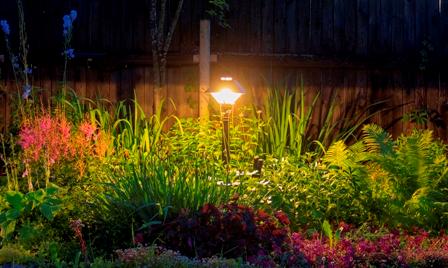Categories: Sharing experience, Sources of light
Number of views: 12309
Comments on the article: 1
Kreonix CORN 6.5 W LED Garden Field Test in Garden Lighting
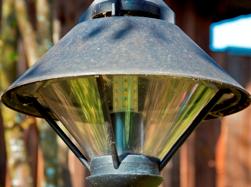 As often happens, everything turned out quite by accident. A friend asked me to deal with the high power consumption of garden lighting in a country house and its reliability. If necessary, I asked to put a separate voltage regulator for lighting, since the mains voltage is unstable and often low.
As often happens, everything turned out quite by accident. A friend asked me to deal with the high power consumption of garden lighting in a country house and its reliability. If necessary, I asked to put a separate voltage regulator for lighting, since the mains voltage is unstable and often low.
About a year ago, an acquaintance already began the struggle for energy savings. He replaced incandescent bulbs in garden lights with compact fluorescent energy-saving lamps. The energy savings turned out to be significant when compact fluorescent lamps were installed instead of 21 pieces of conventional 60-100 W lamps. The company did not stint and put "OSRAM" 24 watts.
The homeowner arranged a saving result. But over time, the disadvantages of the new lamps became noticeable. For example, the base with the electronics of an energy-saving lamp was quite massive and raised the luminous part of the lamp 5 cm higher than the incandescent filament of a conventional lamp. The focus of the lamp shifted.
It seems to be a trifle, if for a chandelier ... And for a garden lamp, this responded by narrowing the direct lighting zone. After all, the lamp hid deeper under the roof of the lamp and the radius of illumination decreased.
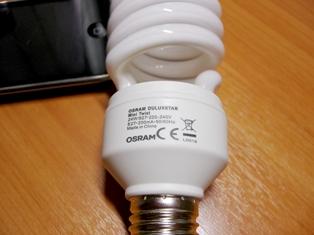
But, as they say, these are trifles. Further more!
Closer to autumn, when heating devices began to be turned on in the village, the voltage in the power supply network, which was already not distinguished by stability and "guest" quality, was drained to 200 Volts.
When turned on, energy savers were lit for a long time, and shone not as brightly as in the summer. This was noticeable to the naked eye. At the moments when the neighbors turned off the heaters, the mains voltage jumped up, to which the lamps responded with flashes of brightness.
But even greater troubles began with the onset of winter!
The voltage in the network fell below 200 volts, the lamps did not shine, but smoldered. However, on particularly frosty days, the lamps refused to light up at all. They quickly failed, and did not work out the working hours promised by the manufacturer in hours.
By the end of winter, the site lighting went out and did not turn on anymore. But it was not about the lamps. The called electrician determined that the miniature photo relay, responsible for turning the lights on and off in the dark, had broken. When the relay was opened, it turned out that the relay contacts were badly burned there.
The owner was wondering why it happened, because 21 lamps of 24 W each consume only 504 W, and the relay says 220 V 3A. Those. the relay must withstand a lot of power! But neither the owner nor the electrician took into account the fact that the starting current of fluorescent lamps can be several times greater than their operating current. And the simultaneous inclusion of a garland of such lamps provokes an electric arc at the contacts of the switch. Here are the contacts and ordered to live long.
Without hesitation, instead of a failed photo relay, an electrician set exactly the same ...
It was a saying. This time we decided to change the OSRAM twisted energy savers to Kreonix LED lamps, as very high quality and affordable. By the way, lamps of this brand are in very famous and important public and private institutions in Russia.
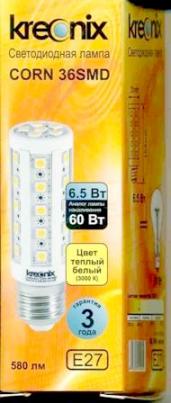
But, these lamps have an important advantage. The fact is that in many cities and towns (like my friend in the Vladimir region), the voltage is unstable and does not correspond to the norm. Its value in volts depends both on the time of peak consumption in the village and on the seasonal factor. There are frequent cases when there is a "phase imbalance" of the power supply and the voltage jumps over 240 volts! This is another reason for the rapid failure of conventional lamps.
CLUSTERWIN's wide range of new Kreonix LED bulbs operate at line voltage 85 to 265 volts! At the same time, the light does not change the intensity, does not fade and does not blink! And the power consumption is less than that of fluorescent lamps! That is, to put it simply, each lamp has its own personal stabilizer, which compensates for both low and high supply voltage. Is it not a celebration of the soul for a summer resident!
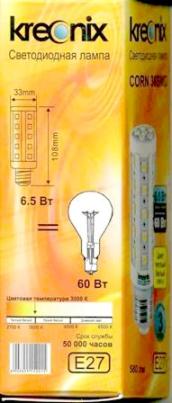
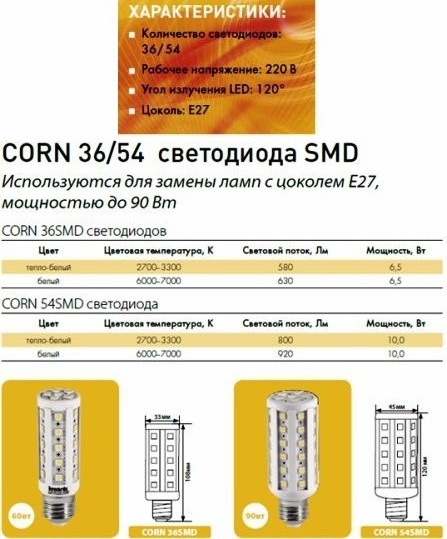
For installation in garden lamps, Kreonix CORN 36SMD 6.5 W lamps of warm white light of 3000 K with small geometric dimensions and the missing “knob” at the base were selected.
The lamps blend harmoniously into the lamp, giving it a touch of modern high-tech. They do not have a matte diffuser, because the design of a garden lamp is such that the light does not enter a person’s eyes. Therefore, these lamps are more effective for illuminating the site.
The level of illumination of a lamp of 580 lm corresponds to a 60 W incandescent lamp, which is enough for our purposes (at first the owner doubted whether it would be darker). The height of the bulb is only 108 mm and the diameter is 33 mm. With such dimensions, we not only returned the lighting zone of the lamp to the level of the manufacturer, but also slightly increased it.
Replacing the photo relay with a more reliable one, we checked its operation, covering the sensor with a black trash bag, and waiting for the night and the lights to turn on, we surveyed a pleasantly lit suburban area with a satisfied owner.
In the photo you can click to enlarge.
Warm white light gives off colors well, making the picture more natural and familiar to the eyes. It is not worthwhile to use 6500K cold light lamps in the residential area, although they shine brighter.
Despite the fact that the mains voltage was less than 210 V, the Kreonix CORN 36SMD 6.5 W LED lamps shone brightly.
When the "beauty" was finished, they began to figure out the savings from replacing OSRAM fluorescent lamps with the Kreonix CORN 36SMD 6.5 watts.
The picture was curious!
It was: 21 bulbs of 24 watts each. Total: 24 x 21 = 505 W = 0.505 kW
With an average duration of 12 hours at night, their consumption will be 0.505 kW x 12 h = 6.06 kW \ h per day.
Accordingly, 6.06 kWh per day x 30 days = 181.8 kWh
The cost of electricity in the Vladimir region for Moscow residents not registered there is 3.75 p. There is no night rate.
181.8 x 3.75 = 681.75 rubles per month! Or 681.75 rubles. x 12 months = 8 181 rubles a year!
And this is with energy-saving lamps!
Now, let's estimate the savings from replacing twisted power-saving devices with Kreonix CORN 36SMD 6.5W LED bulbs.
6.5 W x 21 pcs. = 0.1355 kW \ h
0.1355 kW \ h x 12 hours. = 1.64 kWh per day or per month: 1.64 kWh x 30 days = 49.20 kWh
49.2 kW x 3.75 rub. = 184.5 rub. per day. Or 184.5 rubles. x 12 months = 2 214 rubles a year!
We consider the savings: 8 181 - 2 214 = 5 967 rubles per year!
Is it a lot or a little? Decide for yourself.
Yuri Shurchkov
See also at e.imadeself.com
:

